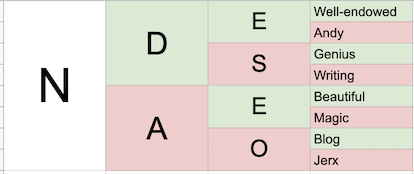The Put It In Your Pocket Technique
/One thing magicians have never really come up with is a good solution to deal with people asking to examine a prop that is unexaminable. The most common advice I used to hear was this:
“Put the item in your pocket and redirect their attention to another trick.”
This is, quite possibly, the dumbest advice that has ever been concocted on any subject ever. If I asked, “How do I un-jam a garbage disposal?” And you replied, “Dangle your testicles in it.” That advice would be no worse than, “When someone wants to examine something they can’t, you should put the item away and move on to something else.”
Like much of the traditional magic “wisdom,” it’s based on a complete unfamiliarity with the way a normal human’s mind works. Hiding something away doesn’t decrease the suspicion on it.
And the idea of moving on to Trick B to lessen the focus on Trick A is profoundly imbecilic. It presupposes a situation where the beginning of Trick B is somehow more interesting to people than the climax of Trick A. If this is true, then Trick A sucks shit. You shouldn’t be doing it.
But let’s take a look at what this type of “audience management” looks like in action. Here is “Celebrity Magician,” Matthew Furman, performing for some people in lab-coats. Watch the first 30 seconds of the video. He does Hundy 500 (or something similar) to change 1 dollar bills to 100s. This will always get a good initial reaction, because it’s very visual. After the trick, the male reaches out for the bills in a somewhat joking manner. Knowing he can’t actually give the bills out, Matthew doesn’t dawdle. He quickly puts them in his pocket and says, “I got a card trick. Comin’ atcha. Happy to see you guys. Figure’d we come and do some tricks. Check it out.”
He has successfully executed the, “I’ll put that in my pocket and move on to something else” technique to assuage people’s inclination to look at the bills. And it seems that many magicians would consider this a success. They didn’t get to look at the bills. That’s a win, right? That’s how braindead traditional magic thinking is. “They didn’t get to examine the object, so they don’t know it’s gimmicked, so they probably just assume it’s magic.”
No.
When it comes to the examinability of any magically altered object, I have a theory that probably no one else will agree with, and it’s this: If you’re not going to let the object be examined, you might as well just expose the trick. You end up in the same place either way.
For example, if you expose the bill trick in the above video, the audience will think: “Oh, he’s got a tricky stack of bills.”
If you put the bills in your pocket and don’t let them be examined, the audience will think: “Oh, he’s got a tricky stack of bills.”
It’s the exact same outcome!
So what’s the solution? Just don’t do a trick if it can’t be examined?
Yeah, that’s exactly the solution. For the amateur magician especially, the idea that you can “manage” your way past the spectator’s interest in a magically altered object is moronic. I’ve made the point before: In a casual, close-up situation where something is magically changed in some manner, the trick isn’t really over until the spectator can look at the object. Not only does whisking the object away not fool anyone, it also makes you look like a complete spazz. “Here… pay attention to this thing I’m showing you. Oh… your interest is at its peak? Okay, this is the point where I’ll put it away.” That not a normal human thing to do.
There are, of course, ways to choreograph your routine/interaction in order to build in switches or vanishes so that an object can be examined (or is no longer there to be examined) at the end. It’s worthwhile to think along those lines. But we undermine the need to do the work in this area when we suggest it’s enough to just put something in your pocket and move on to something else.














